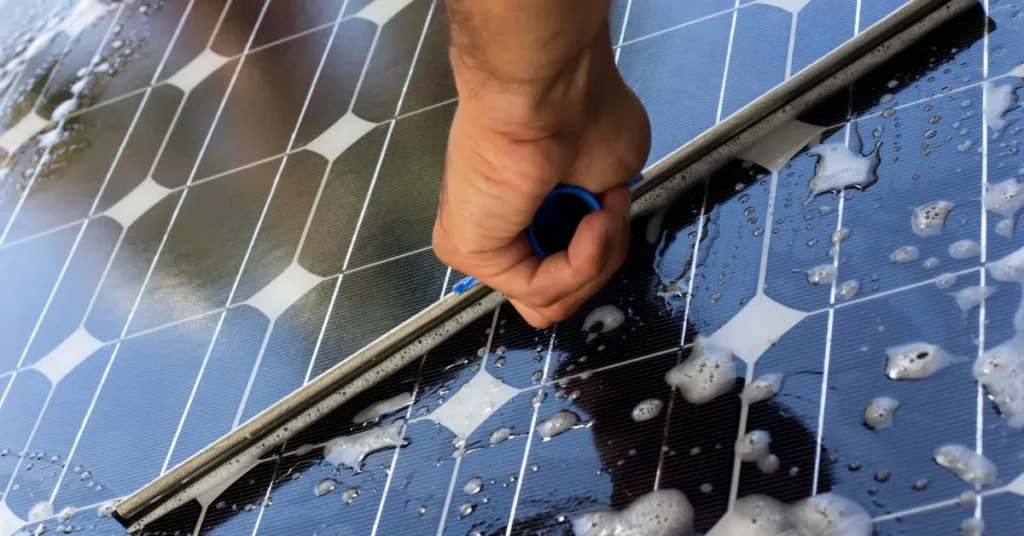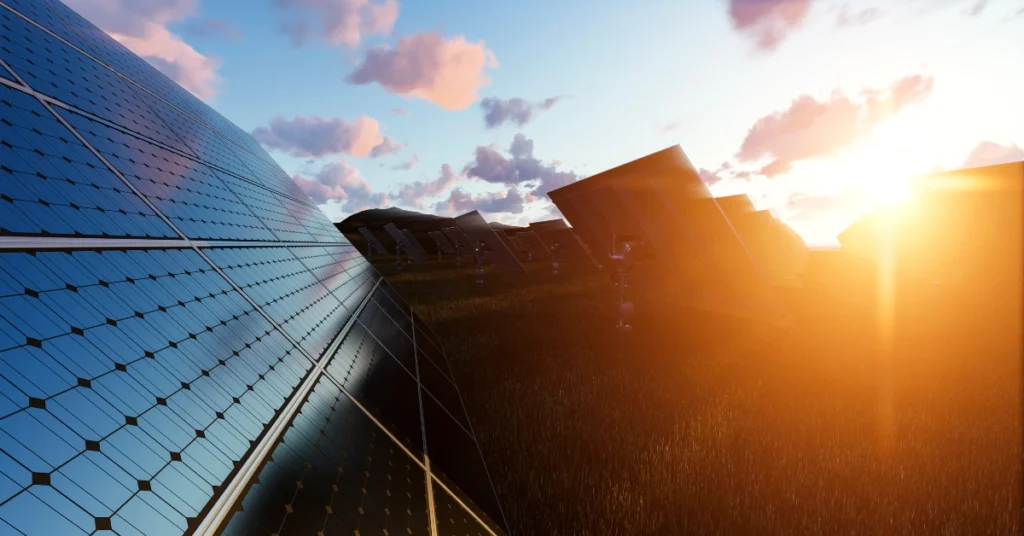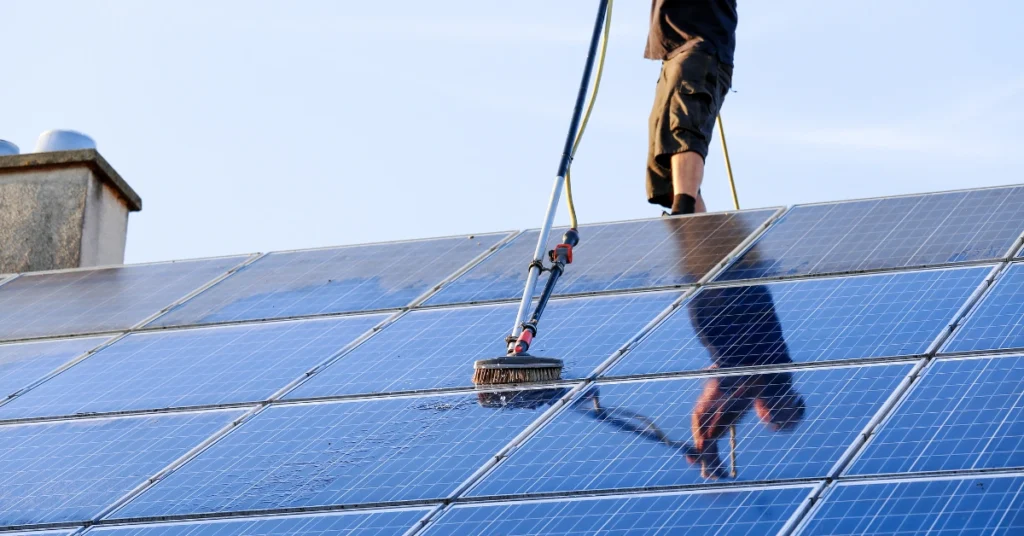Investing in solar panels can significantly reduce operating costs for rental buildings, commercial facilities, and other investment properties. However, the job isn’t finished once the panels are installed. Keeping them clean is a critical part of maximizing their performance. Over time, dust, pollen, bird droppings, and grime accumulate on panel surfaces, impeding their ability to absorb sunlight. In this article, we’ll explore how solar panel cleaning boosts efficiency, why clean panels are especially important for investment properties, and best practices for maintenance.
Impact of Grime on Photovoltaic Performance
Even a thin layer of dirt can cut into a solar panel’s energy production. This soiling effect reduces the amount of sunlight that penetrates the panel’s glass, resulting in a loss of efficiency. The impact of grime on panel output: in some regions, annual energy yield drops by around 7% due to accumulated dust, while in harsher environments it can plummet up to 50%. The impact of grime on photovoltaic performance can range from mild to severe, depending on the location and conditions. Common pollutants include atmospheric dust, soot, ash from wildfires, and organic debris like leaves or bird droppings.
How Solar Panel Cleaning Boosts Efficiency
Regular solar panel washing can dramatically improve power output by removing the layer of grime that blocks sunlight. Field studies have shown just how much solar panel cleaning boosts efficiency: in one case, panels that had been left dirty for a few weeks saw a 50% jump in efficiency immediately after a thorough cleaning. By washing away dust and pollutants, you restore the panels’ ability to capture sunlight at full capacity. Even in less extreme cases, cleaning typically yields a noticeable increase in energy generation, whether it’s a 5% or 20% improvement, that can translate to significant savings or income over time.
A clean panel produces more electricity than a dirty one. This is because sunlight can once again hit the photovoltaic cells unimpeded, allowing the system to operate at its peak. For owners of investment properties, that boost in efficiency means better return on the solar investment. The gains from cleaning accumulate day after day in the form of higher kilowatt-hour output. Over a year, a regularly cleaned array will generate substantially more power compared to one left to collect dust. Proactive dirt buildup cleaning directly combats efficiency losses, keeping your solar asset profitable and productive.
Why Investment Properties Need Clean Panels
Ensuring panels are clean and running at full capacity protects the expected ROI from your solar array. For example, if an apartment building relies on solar to offset common-area electricity costs, dirty panels will reduce those savings. Over time, this can add up to a meaningful financial shortfall. Clean panels, on the other hand, generate more free electricity, improving the property’s net operating income. There’s also a long-term asset protection angle. Allowing grime to accumulate for too long can contribute to performance issues that extend beyond lower output.
Heavy soiling can exacerbate potential induced degradation (PID), an electrical phenomenon that can permanently reduce a panel’s efficiency by creating electrically conductive dirt films on the glass. In damp conditions, accumulated grime might even trigger inverter errors or prevent the system from starting up at full power. Regular cleaning prevents these problems, helping the system last its full lifespan. From a property value perspective, clean solar panels also signal good maintenance. If you ever sell the building, a well-maintained installation with documentation of solar panel maintenance can be a selling point that adds value. Investment property owners may not be on-site daily to notice panel dirt. That’s why many incorporate scheduled cleaning as part of routine maintenance for PV arrays, often hiring professionals to handle the task. In sun-drenched markets like Southern California, property investors often turn to experts like Max’s Real Estate Cleaning for scheduled panel cleanings, ensuring their solar assets continue to deliver strong returns year-round.
PV Array Washing: How Often to Clean Solar Panels
While the ideal cleaning frequency varies based on environmental factors, understanding key considerations and best practices can significantly enhance performance and longevity. Below are essential aspects of solar panel maintenance, ensuring your PV arrays operate at their peak:
- Determining Optimal Cleaning Frequency: The frequency of solar panel cleaning is highly dependent on your property’s geographical location and environmental conditions. For areas with moderate climates and regular rainfall, an annual cleaning might suffice to maintain efficiency. However, properties situated in arid, dusty regions or near significant pollution sources like highways or construction sites will necessitate more frequent attention, potentially quarterly or immediately after major dust events. The primary goal is to prevent the accumulation of dirt and debris that can impede sunlight absorption and diminish energy output.
- Monitoring System Performance: Proactive monitoring of your solar energy system’s production is a key indicator for determining when cleaning is needed. If you notice a greater-than-expected decrease in energy output for the season, dirt accumulation could be the underlying cause. A quick visual inspection of the panels can confirm this suspicion; if they appear visibly grimy or have noticeable debris, it’s likely time for a wash. Regular checks empower property owners to address issues before they significantly impact performance.
- Preventing Water Spots: To avoid mineral deposits and water spots, especially if using tap water, consider using distilled or deionized water for cleaning. Alternatively, promptly drying the panels after washing can prevent spot formation. Many property owners find it beneficial to establish a routine cleaning schedule, such as every six months, and then adjust it based on observed results and the specific environmental conditions of their location. A systematic approach ensures consistent maintenance and optimal performance of your solar energy system.
By implementing these strategies, property owners can effectively manage their solar panel maintenance, ensuring consistent energy production and maximizing the long-term benefits of their renewable energy investment. Regular, thoughtful cleaning, tailored to your property’s unique environment, is a cornerstone of efficient solar power generation.
Tools and Equipment
A variety of tools and equipment are available to ensure solar panels are cleaned safely and effectively. For most residential and small commercial systems, the basic toolkit includes a soft-bristled brush or sponge to gently remove dirt without scratching the panel surface, as well as a garden hose for rinsing away debris. Extension poles can be attached to brushes or squeegees, allowing property owners to clean panels from the ground, minimizing the need to climb onto roofs. For larger or harder-to-reach arrays, specialized solar panel cleaning kits are available; these often include water-fed poles, soft rotating brushes, and attachments for purified or deionized water, which help prevent mineral deposits and streaking. In commercial-scale settings, equipment such as tractor-mounted sprayers or robotic cleaners may be used for efficient large-area coverage. Regardless of the system size, it’s important to avoid abrasive tools and high-pressure washers, as these can damage the panels and reduce their lifespan.
Cleaning Large Commercial Solar Panels and Arrays
Cleaning needs can become more intensive as system size grows. Large commercial or industrial solar installations, like those on office parks, warehouses, or multi-unit apartment complexes, accumulate grime over vast surface areas. It’s one thing to hose down a 5 kW rooftop system on a duplex, but quite another to clean large commercial solar panels spread across hundreds of modules. In these cases, specialized approaches and equipment are often used. For instance, commercial solar farms or expansive rooftop arrays may employ water-fed poles, rotating brush systems, or even robotic cleaners to wash panels efficiently.
Fleet vehicles with mounted tank sprayers can deliver purified water across long rows of panels quickly. In solar farms, crews might use tractor-like washing units to cover ground-mounted panels in bulk. The goal remains the same: to remove dust and debris and restore generation capacity, but on a larger scale to meet high-volume needs. From a cost-benefit perspective, cleaning is typically very worthwhile for large arrays. Even a seemingly small percentage gain in efficiency can translate to huge energy boosts when you have thousands of panels. For instance, regaining 5% output on a 1 MW system yields far more kilowatt-hours than 5% on a home 5 kW system. Operators of commercial solar projects often calculate the optimal cleaning frequency by comparing energy losses to cleaning costs. In especially arid, dusty regions, this can mean multiple cleanings per year. A 10-megawatt solar farm in a high-soil area found it economical to clean panels more than once a year, even though a single cleaning of that 10 MW array costs around $5,000.
Safety Tips and Precautions
When cleaning solar panels, safety should always be the top priority, especially when working on rooftops or around electrical components. Before starting, ensure the system is powered down according to the manufacturer’s instructions to prevent electrical hazards. Use non-slip footwear and a safety harness when accessing a sloped or elevated roof. Never attempt to clean in wet or windy conditions to avoid slips and falls. Avoid using metal tools or abrasive materials that could damage the panels or cause injury. Whenever possible, clean panels from the ground using extension tools, and consider hiring professionals for hard-to-reach or large installations.
DIY vs. Professional Solar Panel Cleaning
Should you clean solar panels yourself or hire out the job? For many investment property owners, this decision comes down to safety, convenience, and scale. DIY cleaning can be effective for smaller installations or single-story roofs, involving simple steps such as rinsing panels with a garden hose and gently wiping them with a soft cloth or brush. Homeowners comfortable with heights might handle a quick cleaning on their own if the panels are easily accessible. However, there are essential precautions: climbing roofs or ladders carries risks, and using the wrong tools can damage the panels. Many investors prefer to enlist a solar panel washing company to save time and avoid hazards. Professional solar panel cleaners are trained to work safely at heights and use proper equipment. They also tend to use purified water and techniques that leave no residue, ensuring a spotless finish without scratches or streaks. Another advantage is that a pro will often spot any issues during the cleaning, alerting you to maintenance needs.
Cost of Cleaning Solar Panels
Hiring a panel cleaning service does come with a fee, but for most property owners, it’s a modest expense well worth the benefits. Professional solar panel cleaning will usually only cost around $150–$300 for a typical residential array. Commercial projects will scale higher, but service providers often offer discounted rates per panel for larger jobs. Given that clean panels can increase energy output significantly, the cleaning frequently pays for itself through the extra electricity generated. Moreover, on investment properties, the cost of a periodic cleaning service is usually far less than the value of the energy gains.
Picking the right solar panel cleaning service is crucial for maintaining the efficiency and longevity of your investment properties’ solar arrays. Beyond basic qualifications, a truly superior service offers a comprehensive approach that ensures both effective cleaning and peace of mind. Consider these key aspects when evaluating potential providers:
- Insured and Experienced Professionals: Prioritize companies that demonstrate a strong commitment to professionalism through proper insurance and extensive experience with solar equipment. A reputable provider will have a proven track record of handling various types of solar installations and understand the nuances of different panel technologies. Their expertise ensures that cleaning is performed safely and effectively, minimizing any risk of damage to your valuable assets.
- Gentle Methods and Positive Reviews: The best solar panel cleaning services distinguish themselves by employing gentle cleaning methods that protect the delicate surfaces of your panels. They utilize techniques and tools that effectively remove dirt and grime without causing abrasions or compromising the integrity of the panels. Look for providers with overwhelmingly positive customer reviews that consistently highlight their effectiveness in cleaning and professionalism. This feedback serves as a reliable indicator of their commitment to customer satisfaction and quality service delivery.
- Transparent Pricing and Process Clarity: A top-tier service will always offer transparent pricing, meticulously outlining all inclusions and potential additional costs upfront. This clarity ensures there are no unwelcome surprises when you receive your bill. They should also be able to provide a detailed explanation of their cleaning process, including the specific type of water used (e.g., deionized water to prevent mineral buildup) and the precise tools employed to guarantee no damage occurs during the cleaning operation. Commitment to detail reflects their professionalism.
- Post-Service Reports and Customer Support: An excellent solar panel cleaning service will provide a comprehensive post-service report detailing the work performed, including any observations about the condition of your solar array. This documentation is invaluable for tracking maintenance and identifying potential issues early. Furthermore, their customer service should be exceptionally responsive and knowledgeable, ready to answer any questions you may have before, during, or after the cleaning. Inquire about guarantees or warranties on their work for added peace of mind.
By carefully considering these critical factors, you can confidently select a solar panel cleaning service that not only enhances the efficiency of your investment properties’ solar panels but also provides exceptional value and reliability.
Solar panels are a long-term investment, and like any investment, they require care to deliver optimal returns. For property owners, clean panels generate more electricity, resulting in greater savings or income. Neglecting your solar array can lead to efficiency loss that quietly erodes your financial benefits over time. On the other hand, implementing a simple cleaning regimen, either DIY or through professionals, will ensure your system consistently operates at peak capacity. Especially for investment properties, where margins matter and performance is closely monitored, maintaining panel cleanliness is an easy win to boost ROI. In summary, regular cleaning is a small effort that yields a big payoff. By keeping dirt and dust at bay, you’ll extend the lifespan of your solar equipment, prevent avoidable performance issues, and squeeze the maximum energy out of every ray of sunshine.
Sources:
- National Renewable Energy Laboratory (NREL) – Scientists Studying Solar Try Solving a Dusty Problem (2021)
- Popular Mechanics – Pollution Could Block 25 Percent of the Light That Would Become Solar Power (2017)
- Solar.com – The Economics of Cleaning Solar Panels (Guest post by Catlin Buchanan, 2023)



